Electric vehicle manufacturer Rivian is focused on improving profitability by streamlining its production process and reducing costs. CEO RJ Scaringe revealed that the company has eliminated over 100 steps from the battery-making process, 52 pieces of equipment from the body shop, and over 500 parts from the design of its SUVs and pickups. This restructuring has led to a 35% reduction in the cost of materials for vans and significant savings for other product lines.
During a recent factory tour in Normal, Illinois, Scaringe highlighted the improvements in the design of parts and the manufacturing plant, making vehicles easier and more cost-effective to build. Rivian’s efforts to cut costs are crucial, especially in the face of high interest rates that deter potential customers from purchasing electric vehicles. Despite never turning a quarterly net profit since its founding in 2009, Rivian is optimistic about achieving profitability this year.
The company’s commitment to working smarter is evident in the second generation of its R1 vehicles, which feature company-built drive units, upgraded software, and new battery packs. The redesigned battery modules, simplified assembly process, and reduced weight contribute to improved manufacturing efficiency. These changes have not only reduced labor time but also increased assembly line productivity by 30%.
While Rivian is financially more stable than some of its competitors, it still faces challenges. The recent plant shutdown has impacted production targets, leading to concerns among investors. However, the company remains focused on cost savings to ensure long-term success and investor confidence.
To accelerate the delivery of its R2 SUVs, Rivian has decided to produce the vehicles at its Illinois plant instead of a planned facility in Georgia. This strategic move is expected to save $2 billion and increase the factory’s capacity to 215,000 vehicles per year. By making informed decisions and prioritizing cost efficiency, Rivian aims to achieve profitability and sustain its growth in the competitive electric vehicle market.










